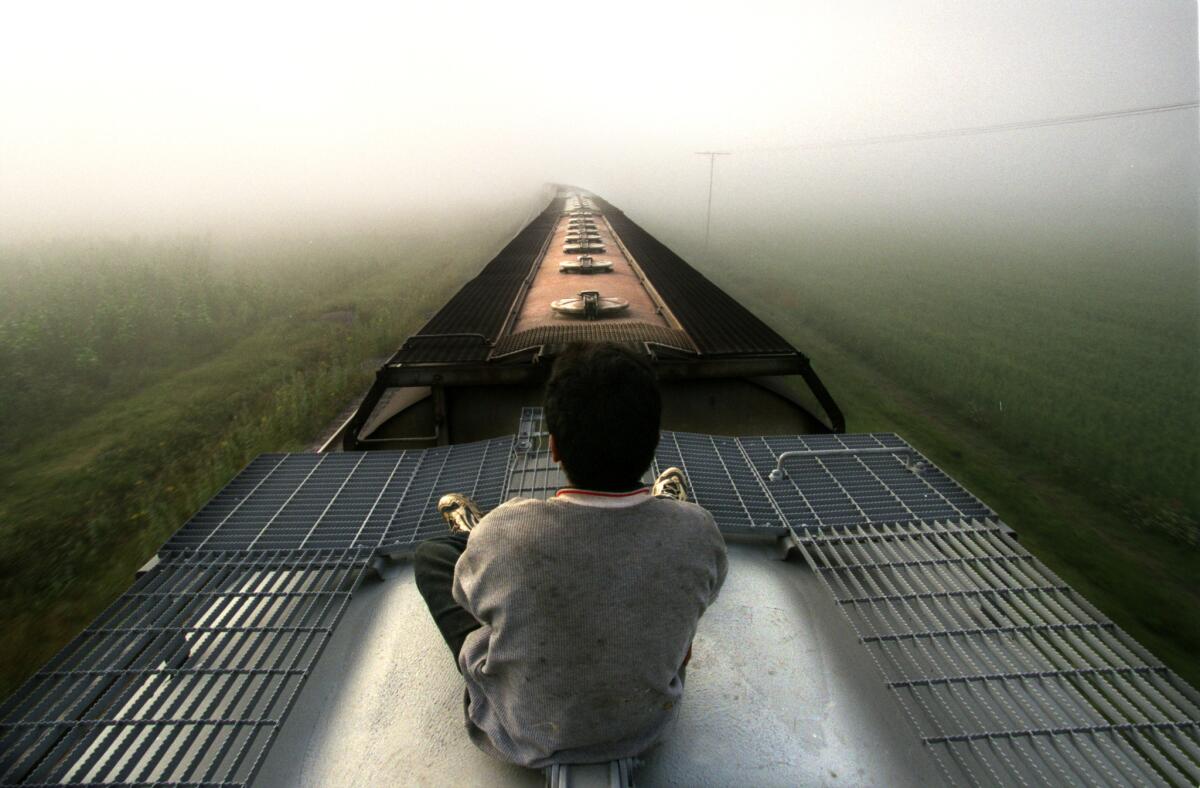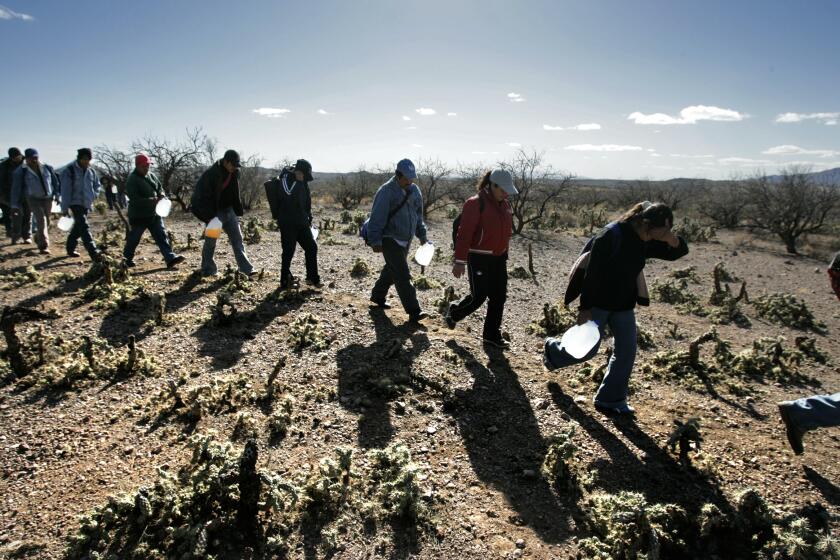Review: Compelling ‘American Dirt’ humanizes a migration tale with care

“One of the very first bullets comes in through the open window above the toilet where Luca is standing. He doesn’t immediately understand that it is a bullet at all, and it’s only luck that it doesn’t strike him between the eyes…. But the wash of bullets that follows is loud, booming, and thudding, clack-clacking with helicopter speed. There is a rash of screams too, but that noise is short-lived, soon exterminated by the gun fire. Before Luca can zip his pants, lower the lid, climb up to look out … the bathroom door swings open and Mami is there.
“‘Mijo, ven,’ she says, so quietly that Luca doesn’t hear her.”
So begins the 2,645-mile, run-for-their-lives journey of 8-year-old Luca and his mother, Lydia, away from a family barbecue turned crime scene, away from their comfortable middle-class life in Acapulco, to el norte, and the possibility of a new life across the border.
Before the day that changed their lives forever, Lydia owned a bookstore, where she befriended a frequent customer, an elegant bespectacled man named Javier who shared her love of certain novels, who wrote bad poetry and shared that with her too. But it wasn’t long before Lydia realized that her friend Javier and the leader of the cartel Los Jardinaros — the man they called La Lechuza for his owlish glasses, the most feared man in the whole state of Guerrero — were one and the same.
Nevertheless, when Lydia’s husband, Sebastián, a career journalist, writes a profile/exposé of La Lechuza, Lydia convinces both Sebastián and herself that the article will appeal to Javier’s vanity, that she and her family will be safe. It is only a matter of days after the article is published that the bullets fly outside the bathroom window, and when the assault is over, sixteen members of Lydia’s family, including Sebastián, are dead, she and Luca spared only by the accidental timing of the bathroom break.
What follows are nearly 400 pages of heart-pounding, page-turning, can’t-put-it-down, stay-up-till-3 a.m., adrenaline-pumping story.
Rigoberto Gonzalez reviews Jeanine Cummins’ ‘American Dirt.’ The novel tells the story of a mother and son on Mexico’s migrant trail in search of a new life.
The two runaways are tracked by the cartel from a hotel room in Acapulco onto a bus bound for Chilpancingo, then smuggled in a van into Mexico City and onto La Bestia, the freight train that rumbles up through the desert to Tijuana, Nogales and Juárez, where coyotes wait to take them across the border. To board the train, they must find a spot where it is unprotected by fences; they must run to grab on before the train speeds up, scramble to the top without being sucked under and cut in half, strap themselves to the roof of a boxcar and duck for every tunnel. On La Bestia, Luca and Lydia meet Soledad and Rebeca, beautiful teenagers running from a human trafficking cartel in Honduras, and the four resolve to stick together.
What is great about how hard this novel is to put down is the hope that it will not be put down. Because it also examines, with sensitivity, care, and complexity of thought, immense, soul-obliterating trauma and its aftermath.
It is also about teeth-gritting, unromantic perseverance. The kind shown by Central American refuge-seekers who arrive at our border daily. “American Dirt” humanizes, better than any news story, the children our government is currently incarcerating, without blankets, without toothbrushes, without flu shots, without hope of seeing their parents ever again. It personifies the will of the mothers we see in flashes on TV, running with their toddlers in their arms, the ones for whom “to go home” means to hand their children to executioners.
I have read several studies about the resilience of women in the face of atrocity, of genocide, of unthinkable cruelty, of rape and murder and dismemberment, of the various tortures powerful men have been inventing for centuries. Lydia, Soledad and Rebeca are the embodiment of that resilience, of that determination. Lydia’s willingness to kill or die for her son, and Soledad’s for her sister, serves to make them 21st century heroines. It also encourages us to ask ourselves: How could we, under the current regime of terror on both sides of the border, do more to help those who are running for their lives?
Jeanine Cummins is not a Mexican national. She is a U.S. citizen of mixed ethnicity with family roots in Puerto Rico who writes in the book, “I married an undocumented immigrant.”
The book has been criticized by authors Myriam Gurba and David Bowles as being full of stereotypes, appropriating and inaccurate. Though several Mexican American and Latino writers (Sandra Cisneros, Julia Alvarez) have come out in support of the book, hoping that it will effect policy change, Bowles wrote that “to elevate this inauthentic book written by someone outside our community is to slap our collective face.”
Cummins anticipates this controversy in the book’s afterword: “When I decided to write this book, I worried that my privilege would make me blind to certain truths, that I’d get things wrong, as I may well have….”
It may be my privilege that leads me to agree with Norma Iglesias Prieto, chair of the Chicana and Chicano Studies Department at San Diego State, who told Cummins, by way of encouragement, “We need as many voices as we can get telling this story.” And it is no doubt my privilege that hopes the novel might give the 52% of white women who voted for Trump in 2016 a reason to reconsider later this year.
When Claudia Rankine’s “Citizen” came out, I suggested that in order for U.S. citizens to get their driver’s licenses renewed, they should have to answer a few simple questions about that book. I thought it again with the publication of Colson Whitehead’s “Underground Railroad.” Likewise, “American Dirt.”
It is hard to dispute the fact that our collective blindness and amnesia as an electorate have caught up to us. To move forward from divisiveness and hate into a collective response to the calamities befalling us, we need to own our past as well as our present. We need to see immigrants not as, in Cummins’ words, “an invading mob of resource-draining criminals,” or “a sort of helpless, impoverished, faceless brown mass, clamoring for help at our doorstep” but as “people with the agency to make their own decisions, people who can contribute to their own bright futures, and to ours, as so many generations of oft-reviled immigrants have done before them.”
“American Dirt” is a vital, well-crafted, compelling and compassionately told story. With a little luck, it might motivate some critical mass of women to rise up and take back the world.
Jeanine Cummins
Flatiron Books: 400 pages; $27.99
Houston is the author of six books of fiction and nonfiction including “Deep Creek: Finding Hope in The High Country.”

L.A. Times Book Club events
The book club’s 2020 lineup includes these upcoming author conversations:
Jan. 27: Ocean Vuong discusses “On Earth We’re Briefly Gorgeous.” Get tickets.
Feb. 15: Luis J. Rodriguez discusses “From Our Land to Our Land” (date updated).
March 11: Jeanine Cummins discusses “American Dirt.”
Info: latimes.com/bookclub
More to Read
Sign up for our Book Club newsletter
Get the latest news, events and more from the Los Angeles Times Book Club, and help us get L.A. reading and talking.
You may occasionally receive promotional content from the Los Angeles Times.







